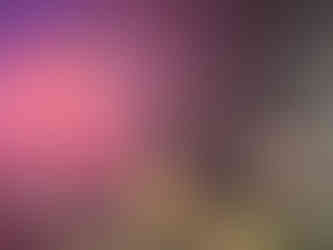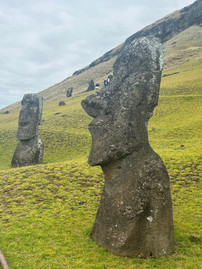The wonderful ancient and contemporary Polynesian culture of Rapa Nui
- bstclair579
- Nov 21, 2024
- 6 min read
After dropping Zach and Cam at the airport for their flight home, I had a week before I was flying home to reunite with Sheri, see family, and celebrate mom's birthday. So I booked a flight to Rapa Nui (Easter Island) for five days/four nights. Rapa Nui is basically tied with Tristan da Cunha for the remotest inhabited island in the world. It is 1,931 km from Pitcairn Island, as compared to 2,430 km from St. Helena Island for Tristan da Cunha, but is further away from a continental land mass. Rapa Nui anchors the southeastern corner of the Polynesian Triangle in the Pacific Ocean (with New Zealand to the southwest and Hawaii to the north).
Rapa Nui is best known for the approximately 1,000 stone statues, called moai, that were carved by the early Rapa Nui people and moved to various locations around the island.
It is hypothesized that Polynesians arrived on the island in about the 12th century. It is amazing to imagine how they found their way to Rapa Nui in their catamarans from other islands over thousands of kilometers away. At first contact with Europeans, the population was between 3,000 and 4,000. The population in the 1870s had declined to only 111 people due to European diseases, Peruvian slave raiding expeditions in the 1860s, and immigration to other islands such as Tahiti. The island was annexed by Chile in 1888. The population now has about 8,500 people, half of whom are of Rapa Nui heritage. Most of the population of Rapa Nui lives in one town, Hanga Roa. Islanders were forced to live in Hanga Roa after Chile granted concessions to a single landowner.
After arriving at Rapa Nui, I walked into town from the airport, bought my ticket for the National Park, and wandered around town, checking out some of the moai in town and getting something to eat before heading to my AirBnB. Hanga Roa is a nice, peaceful small town. There are no large hotels or developments. It has a strong community feel. Horses and dogs seem to pretty much have the run of the place, roaming free. The dogs are very friendly, although they seem to like to pester the horses. There is some good surfing on the waves near the harbor. Soccer is quite popular, for all ages, and I watched a bit of some excellent matches. One evening I went to a small music festival with some great music. Another evening I went to a dance show. The dancers seemed to really enjoy performing for the audience, including a couple of young girls that were the next generation of proud Rapa Nuians. The dancers invited audience members to dance with them. You could tell who were the tourists from Chile because they were excellent dancers - as I suspect are most Latin Americans. At the end of the show, they recognized those in the audience that had birthdays, including a charming older lady. What I love about Rapa Nui is that it is so relaxing with such a strong, proud Polynesian culture. It's what I wish Hawaii was more like.
My AirBnB was a nice little cabana about 2 km from town, owned by a Swiss guy, Peter, and his wife who is Rapa Nuian. I enjoyed visiting with Peter and learning about his life. The AirBnB was a bit far from town, but I enjoyed the long walk along the coast past some nice moai and an interesting cemetery. The sunset past the moai called Anu Tahai is spectacular. Lots of people gather there to enjoy the view. On my last evening I enjoyed dinner with a great group of folks that I had met on one of my tours, especially Eric and his daughter, Alesha, from Scotland, and Guillaume from Switzerland.
Most of the moai and other archaeological sites are protected within the Rapa Nui National Park, which makes up 42% of the island. To visit the sites you are required to take a tour. I took two different tours of the island to see and learn about the archaeological sites. The first tour involved a full-day circle around most of the island.
The first stop was a restored village site, including a boat-shaped Rapa Nui dwelling, and a stone structure used to grow their crops to protect them from the wind and conserve water. The second stop was a site with toppled moai, Anu Akahanga. This is how the moai platforms looked when most Europeans arrived to Rapa Nui in the 19th century. The island was first visited by a Dutch explorer in 1722 on Easter Day; thus, the name given to the island by Europeans, Easter Island. By the time French missionaries arived in the 1860s, all of the moai were toppled apparently from fighting between different communities. At the same time, the island experienced severe environmental degradation and deforestation. There are different hypotheses about the cause of the environmental degradation, but the introduction of the Polynesian rat is likely a major factor.
The moai are present at the sites of many former communities around the island. They sit atop a platform, always facing towards the village with their backs against the sea, as if looking over the village for protection. Most moai were carved from a quarry some distance away and moved to the villages near the sea. The moai had a top knot carved from a different type of red volcanic rock from a different quarry.
Our next stop was the main quarry on the island, Rana Raraku. There are about 400 moai at the quarry. Most were actually completed when work stopped and the quarry was suddenly abandoned. The moai are scattered around the site, their heads sticking out of the ground. They are full-sized, but erosion has resulted in soil covering most of the body of the moai. One moai is still in the rock of the quarry, lying on its back waiting to be freed. Another moai is unique in that it is of a different style and is kneeling.
Rana Raraku also included another unique feature - the remotest toilet in the world😊.
The next stop was Ahu Tongariki, a lineup of 15 moai with a beautiful backdrop of the sea. A 9.4 earthquake in 1960 off the coast of Valdivia, Chile, (the largest recorded) resulted in a tsunami that washed the toppled moai inland. The Japanese were exhibiting one of the moai in Japan at the time (dubbed the "traveling moai") and were enamored with them. After the tsumani, the moai at Ahu Tongariki were restored and raised upon the platform with donations from a Japanese company.
We then drove across the island to a beautiful, palm-fringed beach on the north coast, Anakena. This is the site where the first Rapa Nui king landed. It is also the site where one of the first moai was re-erected by Thor Heyerdahl and locals in 1955. The site has a beautiful row of moai on a platform with their backs to the beach.
The second tour was to the ceremonial village of Orongo. After the building and raising of moai stopped, a new religion arose known as the bird-man cult. The cult involved a ceremonial ritual in which contestants swam out to a nearby islet and awaited the arrival of the first sooty terns to nest on the island. The contestant that was able to collect the first egg would then be the winner, and would swim back to the ceremonial village overlooking the islet with the egg in a reed basket attached to their forehead. The patron of the contestant was then given special privileges over the next year. The site is quite spectacular. The village sits on the edge of a crater with a lake at the bottom. Also, scattered around the island are numerous petroglyphs, many that show the figure of the bird-man.
During the tour we also visited a site, Ahu Vinapu, in which the back walls of the platform were made of carefully carved, tight basalt blocks, the resemblance of which led to some archaeologists to speculate influence by the Inca.
On October 9th, I returned to Santiago with some time to get organized - and a couple more days skiing at Valle Nevado - before flying home on October 14.

































































































































































Comments